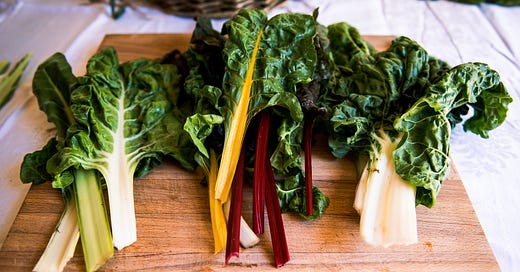Simple Cooking and The Garden
When applied to cooking, “simple” may not be the watchword of the day. But to my sense, simple food is the most satisfying. Of course, what constitutes “simple” food is a subject all on its own. But for starters, food that tastes singularly and entirely of itself is one definition. “Simple” can apply equally to a dead-ripe fig as it does to a long-cooked braise that spotlights its principal ingredient. But “simple” is a result that doesn’t necessarily describe the means of achieving it.
In my hillside garden right now, I have the very last of the Japanese cucumbers bearing slender, thin-skinned fruit I could munch right off the vine. Or I might intervene and take them into the kitchen, peel and slice them while still warm from the afternoon sun, and dust them with salt. I enjoy them either way. Sometimes nothing, or sometimes a little something is enough.
I have also had abundant crops of Swiss Chard. Many gardeners grow chard as an annual crop and pull it from the ground when it starts looking depleted at the first autumn chill. But chard has a very long growing season and a relatively long life cycle. As a biennial plant, it grows roots, abundant stems, and leaves in the first growing season, then bolts to flower and seed during the second. Throughout its life cycle, it is generously edible. Chard flourishes year around in the moderate to cool climate of my Berkeley garden. Leaving the plants in the ground through winter builds robust root systems in the cold soil that sprout vigorously in spring and summer. In the awakening ground, the plants push out lush laterals of varying sizes.
Chard contains two bitter compounds. Tasting it alone, anyone could tell fairly quickly that it’s not for eating as is.
Because chard grows indeterminately, you inevitably end up with a mixed bunch of variously-sized stalks and leaves when you harvest it. This is also how you will likely encounter chard in the market. Some tender leaves sit on tender ribs, while others, thicker and sturdier, expand on more fibrous stalks. At every stage, chard is more resistant than yielding, and even the most delicate leaves don’t have much give in the raw state. By the way, I always pass right by those salad mix bins that include young chard, forms of Asian leaf cabbages, and young kale. On textural grounds alone and to my taste, these greens just don’t jive with the more tender mix of mesclun.
Chard is a vegetable that assuredly needs to be cooked, and over the past months, I’ve been cooking a lot of it. We often put much care into cooking meat to achieve that perfect point. We toast our bread to an even brown and hasten to spread the butter so it just begins to melt in the residual heat. We take care to fry our potatoes to a golden crisp. The same attention yields equally special results when placed on the cooking of a vegetable like chard.
Cooking Chard
Keep reading with a 7-day free trial
Subscribe to Notice! to keep reading this post and get 7 days of free access to the full post archives.




